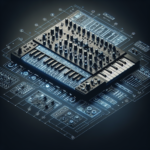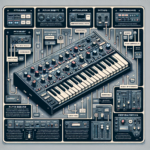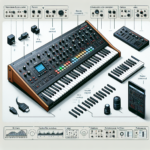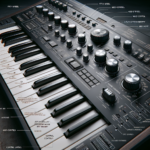Korg MicroKey Air 49: Comprehensive Guide to Features, Setup, and Performance
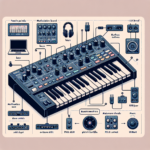
Introduction
The Korg MicroKey Air 49 is a versatile MIDI controller designed to meet the needs of both amateur and professional musicians. With its compact design and wireless capabilities, it offers a convenient solution for music production, live performances, and studio sessions. This guide will provide a comprehensive overview of the Korg MicroKey Air 49, covering its features, setup, performance, and more.
Korg is a well-established brand in the music industry, known for its innovative and high-quality musical instruments and equipment. With decades of experience, Korg has built a reputation for producing reliable and user-friendly products that cater to a wide range of musicians.
Key Features Overview:
- 49 velocity-sensitive keys
- Bluetooth connectivity for wireless operation
- Compact and lightweight design
- USB-powered with optional battery operation
- Compatible with major DAWs and music software
- Assignable controls for customization
Design and Build Quality
Physical Design
The Korg MicroKey Air 49 features a sleek and compact design, making it an ideal choice for musicians with limited space. Measuring approximately 28.35 inches in length and weighing just over 2 pounds, it is easy to transport and set up in various environments. The controller is constructed from high-quality plastic, providing a durable yet lightweight build.
Portability
One of the standout features of the Korg MicroKey Air 49 is its portability. Its compact size and lightweight design make it easy to carry around, whether you’re heading to a studio session or a live performance. Additionally, the wireless Bluetooth connectivity eliminates the need for cumbersome cables, further enhancing its portability.
Durability
Despite its lightweight design, the Korg MicroKey Air 49 is built to withstand regular use. The high-quality plastic construction ensures durability, while the keys and controls are designed to endure frequent playing and adjustments. Overall, the build quality is robust, making it a reliable choice for both studio and live applications.
Setup and Configuration
Initial Setup
Setting up the Korg MicroKey Air 49 is a straightforward process. Follow these steps to get started:
- Unbox the controller and ensure all components are present.
- Connect the controller to your computer using the provided USB cable or pair it via Bluetooth.
- Power on the controller by pressing the power button.
- Launch your preferred DAW or music software.
- Configure the MIDI settings within your software to recognize the Korg MicroKey Air 49.
Software Installation
To fully utilize the features of the Korg MicroKey Air 49, you may need to install additional software or drivers. Visit the Korg website to download the necessary drivers and software, such as the Korg KONTROL Editor, which allows for advanced customization and control mapping.
Compatibility
The Korg MicroKey Air 49 is compatible with a wide range of operating systems and DAWs. Supported operating systems include Windows 7 or later and macOS 10.8 or later. The controller is also compatible with popular DAWs such as Ableton Live, FL Studio, Logic Pro, and more. Additionally, it can be used with various music software and virtual instruments.
Features and Functionality
Key Features
The Korg MicroKey Air 49 boasts several key features that enhance its functionality and versatility:
- 49 Velocity-Sensitive Keys: The keys are responsive to touch, allowing for expressive playing and dynamic control.
- Bluetooth Connectivity: The wireless Bluetooth connection provides a cable-free setup, reducing clutter and increasing mobility.
- USB-Powered: The controller can be powered via USB, eliminating the need for an external power source. It also supports battery operation for added convenience.
- Assignable Controls: The controller features assignable knobs and buttons, allowing users to customize their setup and control various parameters within their DAW or software.
Customizability
The Korg MicroKey Air 49 offers extensive customization options, enabling users to tailor the controller to their specific needs. Using the Korg KONTROL Editor software, users can assign different functions to the knobs and buttons, create custom MIDI mappings, and save their settings for future use. This level of customization makes the controller suitable for a wide range of musical styles and workflows.
Unique Functions
One of the unique functions of the Korg MicroKey Air 49 is its arpeggiator mode, which allows users to create complex arpeggios with ease. Additionally, the controller features a sustain button, which can be used to sustain notes without the need for a separate sustain pedal. These unique functions add to the versatility and creative potential of the controller.
Integration with DAWs
The Korg MicroKey Air 49 integrates seamlessly with popular DAWs, providing a smooth and efficient workflow. For example, in Ableton Live, users can easily map the controller’s knobs and buttons to control various parameters, such as volume, pan, and effects. Similarly, in FL Studio and Logic Pro, the controller can be used to trigger samples, play virtual instruments, and control automation.
Advanced Features
The Korg MicroKey Air 49 includes several advanced features that enhance its functionality. These include aftertouch, which allows for additional expression by applying pressure to the keys after they have been pressed, and chord mode, which enables users to play complex chords with a single key press. These advanced features make the controller a powerful tool for both live performances and studio production.
Performance
Latency and Responsiveness
The Korg MicroKey Air 49 delivers excellent performance in terms of latency and responsiveness. The Bluetooth connectivity ensures a stable and low-latency connection, allowing for real-time playing without noticeable delays. The velocity-sensitive keys are highly responsive, providing a natural and expressive playing experience.
Real-World Usage
In practical scenarios, the Korg MicroKey Air 49 performs exceptionally well. Whether used in a studio setting for music production or during live performances, the controller offers reliable and consistent performance. The wireless connectivity and compact design make it a convenient choice for musicians on the go, while the customizable controls and advanced features provide the flexibility needed for professional use.
User Experience
Overall, user feedback for the Korg MicroKey Air 49 has been positive. Users appreciate the controller’s portability, ease of setup, and versatile features. The responsive keys and customizable controls are frequently highlighted as standout features, while the wireless connectivity is praised for its convenience. Some users have noted minor issues with Bluetooth connectivity, but these are generally resolved with proper setup and configuration.
Applications and Use Cases
Beginner vs. Professional Use
The Korg MicroKey Air 49 is suitable for both beginners and professionals. Its user-friendly design and straightforward setup make it an excellent choice for those new to MIDI controllers, while its advanced features and customization options cater to the needs of experienced musicians and producers.
Studio Use
In a studio environment, the Korg MicroKey Air 49 excels in music production and recording. Its compact size makes it easy to integrate into any setup, while the customizable controls and advanced features provide the flexibility needed for complex productions. The controller’s compatibility with major DAWs ensures a smooth workflow, making it a valuable tool for any studio.
Live Performance
The Korg MicroKey Air 49 is also well-suited for live performances. Its portability and wireless connectivity make it easy to set up and use on stage, while the responsive keys and customizable controls allow for expressive and dynamic performances. The controller’s durability ensures it can withstand the rigors of live use, making it a reliable choice for gigging musicians.
Specific Genres
The Korg MicroKey Air 49 is versatile enough to excel in various musical genres. Its responsive keys and customizable controls make it ideal for electronic music genres such as EDM and hip-hop, where precise control and dynamic expression are essential. Additionally, the controller’s advanced features, such as aftertouch and chord mode, make it suitable for classical and jazz music, where nuanced playing and complex harmonies are required.
Pros and Cons
Pros:
- Compact and lightweight design
- Wireless Bluetooth connectivity
- Responsive velocity-sensitive keys
- Customizable controls and advanced features
- Compatible with major DAWs and music software
Cons:
- Minor issues with Bluetooth connectivity
- Limited number of keys compared to full-sized keyboards
- No built-in display for visual feedback
Common Issues and Troubleshooting
Known Issues
Some users have reported minor issues with Bluetooth connectivity, such as occasional disconnections or difficulty pairing the controller with their computer. Additionally, some users have experienced latency issues when using the controller wirelessly.
Troubleshooting Tips
To overcome Bluetooth connectivity issues, ensure that your computer’s Bluetooth drivers are up to date and that there are no other devices interfering with the connection. If you experience latency issues, try using the controller with a USB connection instead of Bluetooth. Additionally, adjusting the buffer size and latency settings within your DAW can help reduce latency.
Customer Support
Korg offers reliable customer support for the MicroKey Air 49. Users can access support through the Korg website, where they can find FAQs, user manuals, and software downloads. Additionally, Korg provides email and phone support for more specific inquiries. Overall, the brand’s customer support is responsive and helpful, ensuring that users can resolve any issues they encounter.
Comparisons with Similar Controllers
Competitor Comparison
When compared to similar MIDI controllers from other brands, the Korg MicroKey Air 49 stands out for its wireless Bluetooth connectivity and compact design. Competitors such as the Akai MPK Mini and the Novation Launchkey Mini offer similar features but lack the wireless capabilities of the MicroKey Air 49. Additionally, the Korg controller’s advanced features, such as aftertouch and chord mode, provide added value compared to its competitors.
Feature Comparison
In terms of features, the Korg MicroKey Air 49 offers a good balance of functionality and portability. While it may have fewer keys than some full-sized controllers, its compact design and wireless connectivity make it a more convenient option for musicians on the go. The customizable controls and advanced features also give it an edge over other compact controllers, making it a versatile and powerful tool for both studio and live use.
Conclusion
Summary
The Korg MicroKey Air 49 is a versatile and portable MIDI controller that offers a range of features to meet the needs of both beginners and professionals. Its compact design, wireless Bluetooth connectivity, and customizable controls make it a convenient and powerful tool for music production, live performances, and studio sessions.
Who Should Buy This?
The Korg MicroKey Air 49 is an excellent choice for musicians who need a portable and versatile MIDI controller. Its user-friendly design makes it suitable for beginners, while its advanced features and customization options cater to the needs of experienced musicians and producers. Whether you’re producing music in a studio or performing live on stage, the Korg MicroKey Air 49 offers the functionality and flexibility needed to enhance your workflow.
Final Thoughts
Overall, the Korg MicroKey Air 49 is a reliable and feature-rich MIDI controller that delivers excellent performance in a compact and portable package. Its wireless connectivity, responsive keys, and customizable controls make it a valuable tool for any musician, while its advanced features provide added creative potential. If you’re in the market for a versatile and portable MIDI controller, the Korg MicroKey Air 49 is definitely worth considering.
FAQ
Is the Korg MicroKey Air 49 compatible with my DAW?
The Korg MicroKey Air 49 is compatible with major DAWs such as Ableton Live, FL Studio, Logic Pro, and more. It can also be used with various music software and virtual instruments.
How do I connect the Korg MicroKey Air 49 to my computer?
You can connect the Korg MicroKey Air 49 to your computer using the provided USB cable or via Bluetooth. For Bluetooth connectivity, ensure that your computer’s Bluetooth drivers are up to date and follow the pairing instructions provided in the user manual.
Does the Korg MicroKey Air 49 require an external power source?
No, the Korg MicroKey Air 49 can be powered via USB, eliminating the need for an external power source. It also supports battery operation for added convenience.
Can I customize the controls on the Korg MicroKey Air 49?
Yes, the Korg MicroKey Air 49 features assignable knobs and buttons that can be customized using the Korg KONTROL Editor software. This allows you to create custom MIDI mappings and assign different functions to the controls.
What should I do if I experience latency issues with the Korg MicroKey Air 49?
If you experience latency issues, try using the controller with a USB connection instead of Bluetooth. Additionally, adjusting the buffer size and latency settings within your DAW can help reduce latency.
Where to Buy
The Korg MicroKey Air 49 can be purchased from various retailers, including major music equipment stores and online marketplaces. Some of the well-known retailers that carry this product include Guitar Center, Sweetwater, and Amazon. Be sure to check for availability and compare prices to find the best deal.

